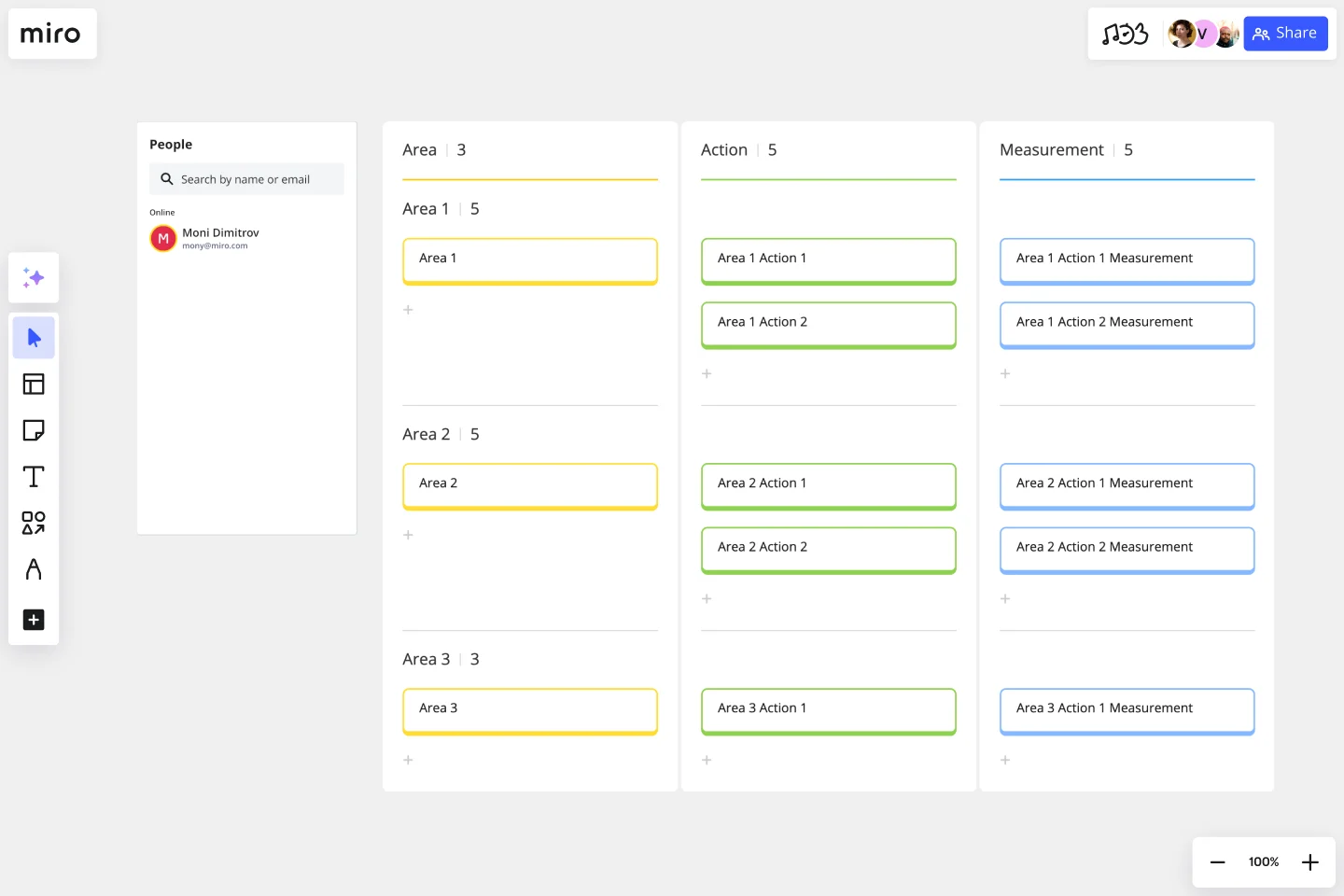Corrective Action Plan Template
Correct for any undesirable actions, outcomes, or behaviors that occur in the workplace. Document everything in a written framework with actionable steps using Miro’s template for corrective action.
About the Corrective Action Plan Template
Once in a while, a manager or HR representative must deliver a corrective action plan to an employee. It’s a difficult conversation, but when inappropriate behavior occurs or job performance fails to meet expectations, the best course of action is to document the infraction. Not only does it help drive the conversation between HR, the manager, and the employee, but it also paves the way for actionable next steps for improvement.
Keep reading to learn more about how to use this simple Corrective Action Plan Template.
What is a corrective action plan?
A corrective action plan takes difficult conversations — regarding behavior or job performance — and puts them into a professional, written framework so that the process, next steps, and details of the conversations are documented. A corrective action plan might include the following:
A write-up of the deficiency (behavioral or performance) and why it has created a disconnect in the expectations of the role.
An HR-approved template describing what is included in the corrective action plan and what steps must be followed.
A process of stop, start, and continue is clearly laid out.
Clarification of roles & responsibilities.
A specification of the ramifications of not following the corrective action plan.
This might seem like a lot of work for a manager or HR team member, but that’s why having an easy-to-use template is just what you need to simplify the tasks!
When to use corrective action plans
Corrective action plans aren’t always negative in nature. Sure, the most common use case might be combating behavior issues, but corrective action can also signal the need for sweeping changes within an organization or team. Put more simply: corrective action can be looked at like quality assurance within individuals or teams that pinpoints a problem, then sets out to fix a specific behavior, task, process, or product.
Create your own corrective action plan
When it comes to corrective action plans, the most important thing is eliminating murky communication, aligning expectations, and providing step-by-step instructions for your employee. Here’s how to create your own, using Miro’s easy pre-made corrective action plan template.
Set a deadline. Set a deadline for completing the steps for corrective action. Also make sure you clearly outline the consequences for not meeting the deadline.
Set priorities and realistic goals: Whether this is an action plan for an individual or a team, setting yourself up for success means setting up priorities and goals.
Document everything: Stakeholders, metrics, dates, expected resolution. Everything should be carefully documented so you have a record of the action plan.
Define the problem! Every corrective action plan must first start with a problem that must be addressed. Make sure you write this down.
Get started with this template right now.
Project Timeline Builder
Works best for:
Timeline, Planning
The Project Timeline Builder template is a powerful tool for planning and managing project timelines. It helps you break down projects into manageable tasks, set deadlines, and track progress. This template ensures you stay organized and meet your project goals efficiently.
Scenario Planning Template
Works best for:
Planning
The Scenario Planning Template simplifies the complex process of strategizing and envisioning various future scenarios. The template’s clear structure helps teams and individuals effectively navigate the multifaceted steps of project planning and execution. A standout benefit of this template is its capability to foster structured thinking. With its distinct sections ranging from definition to action, it ensures that ideas are organized coherently, promoting logical progression and reducing the chances of oversight, making the planning process both efficient and comprehensive.
Backlog Refinement with Jira Template
Works best for:
Agile, Backlog Refinement
The Backlog Refinement with Jira template in Miro improves collaboration among team members. It provides a visual and interactive space for teams to review, prioritize, and clarify upcoming work items together in real time. This collaborative approach ensures alignment on priorities and details, leading to a more organized and efficient workflow. The seamless integration with Jira automatically syncs all changes, reducing the need for manual updates and keeping both platforms up-to-date.
Event Planning Template
Works best for:
Planning, Workshops
Whether you’re planning a product launch, fully remote conference, or milestone event, the Event Planning Template will act as a visual checklist and map for all the details you need to consider before the big day. The Event Planning Template is an adaptable way to make sure the creative and strategic vision of your event doesn’t get lost in the details. By mapping out different sections - from the marketing plan, to the agenda, to snacks and swag for guests — you and your team can focus on the details most important to your functions, and collaborate as needed when overlaps occur.
Kubernetes Architecture Diagram Template
Works best for:
Software Development, Diagrams
Use the Kubernetes Architecture Diagram template to manage your containerized applications better and bring your apps’ deployment, management, and scalability to the next level. This template helps you lower the downtime in production and allows you to have a more agile app production. Improve the deployment of your apps by visualizing every step of the process with the Kubernetes Architecture template. Try it out, and see if it works for you and your team.
Hiring Process Timeline
Works best for:
Timeline, Planning
Streamline your recruitment process with the Hiring Process Timeline by Rizwan Khawaja. This template helps you organize every step of hiring, from job advertisement to final onboarding. Visualize timelines, track candidates, and ensure an efficient hiring workflow. Perfect for HR professionals aiming to improve their recruitment strategy and reduce time-to-hire.
